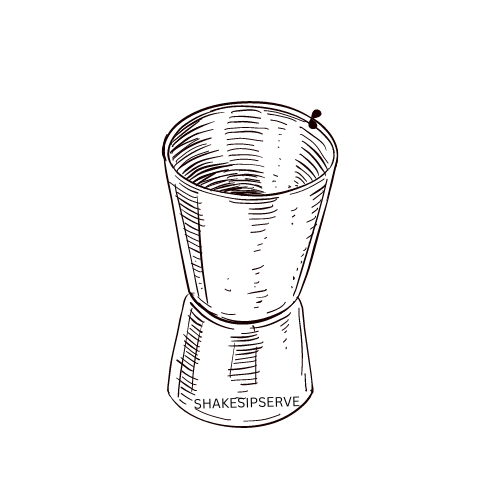Welcome to the fascinating world of mixology, Learn how to use a jigger to give the perfect ratio pour every time
Welcome to Shake, Sip, Serve, your one-stop shop for all things bartending.
I’m your host, KAD, and I’ve been slinging drinks and navigating the world of hospitality for over two decades.
The past 15 years, I’ve perfected my bartending skills, experimented with countless flavor combinations, and learning a thing or two about how to keep the party going behind the bar.
Whether you’re a seasoned bartender like me just looking for some fresh inspiration or a complete beginner who is eager to whip up impressive cocktails at home, Shake, Sip, Serve is here to be your guide.
In the below blog, I’ll be sharing my knowledge and experience on everything from classic cocktails and innovative new creations to essential bartending techniques and industry secrets. I’ll also be offering tips on stocking your home bar, mastering the art of presentation, and creating a memorable experience for your guests.
So, grab your shaker, dust off your favorite glassware, and get ready to embark on a delicious journey into the world of bartending!
Let’s Shake, Sip, and Serve up something amazing together.
Disclaimer: This post contains affiliate links. If you purchase through these links, I may earn a small commission at no additional cost to you.
In the world of mixology, where art and science converge, precision is paramount. Just as a chef meticulously measures ingredients for a culinary masterpiece, a bartender relies on accurate measurements to create perfectly balanced and flavorful cocktails. The jigger, a seemingly simple tool, is the key to unlocking this precision, ensuring consistency and quality in every pour.
The jigger, a seemingly simple tool, is the key to unlocking this precision, ensuring consistency and quality in every pour. While the exact origins are debated, the standardized double-sided jigger we recognize today began to emerge in the late 19th century, coinciding with the rise of classic cocktails. Its invention is often attributed to a bartender named “Professor” Jerry Thomas, a prominent figure in the early days of mixology, though definitive proof remains elusive. Regardless of its precise origins, the jigger quickly became an indispensable tool, revolutionizing cocktail creation.
This comprehensive guide delves into the world of jiggers, exploring their significance, various types, proper usage, maintenance, and their crucial role in achieving cocktail perfection.
1. The Indispensable Role of Measurement in Cocktail Crafting:
The creation of a well-balanced cocktail is a delicate dance of flavors. Each ingredient, from the base spirit to the smallest dash of bitters, plays a crucial role in the overall composition. Accurate measurements, facilitated by the jigger, are not merely a suggestion; they are a necessity for achieving the intended harmony. A slight deviation in the quantity of one ingredient can drastically alter the taste profile, throwing off the balance and potentially ruining the drink. The jigger empowers bartenders to replicate classic recipes with unwavering consistency, ensuring that every Martini, Manhattan, or Margarita tastes exactly as it should. Moreover, precise measurements provide a foundation for experimentation and innovation. When creating new cocktails, accurate measurements allow bartenders to understand the impact of each ingredient and to fine-tune their recipes until they achieve the desired flavor profile.
2. A Comprehensive Overview of Jigger Types:
Jiggers come in a variety of shapes and sizes, each designed with specific features to enhance accuracy and efficiency.
- Classic Double-Sided Jiggers: The most common type of jigger, the double-sided jigger, features two different measurement increments on each end. These increments typically cover the most frequently used measurements in cocktail recipes, such as 1 ounce, 1.5 ounces, and 2 ounces. Double-sided jiggers are versatile, convenient, and widely used in both professional and home bars.
- Japanese-Style Jiggers: Characterized by their sleek, elongated design and precise measurement markings, Japanese-style jiggers are favored by bartenders who prioritize both accuracy and aesthetics. They often feature finer gradations, allowing for measurements as small as 0.25 ounces, and their unique shape and pour spouts facilitate smooth and controlled pours.
- Multi-Level Jiggers: Multi-level jiggers feature multiple measurement lines within a single cup, eliminating the need to switch between different jiggers for various quantities. This design enhances efficiency, particularly in high-volume bar settings, by streamlining the measuring process.
- Specialty Jiggers: Specialty jiggers are designed for specific purposes or aesthetic preferences. Some may incorporate built-in strainers, while others may be crafted from unique materials like copper or gold-plated stainless steel. These jiggers can add a touch of personality to a bar setup and may offer additional functionality.
3. A Step-by-Step Guide to Jigger Usage:
Mastering the use of a jigger requires practice and attention to detail.
- Step 1: Ingredient Selection: Ensure you have the correct ingredient and that it is at the appropriate temperature for the cocktail you are making.
- Step 2: Jigger Selection: Choose the appropriate jigger side for the measurement required in your recipe. Ensure the jigger is clean and dry.
- Step 3: Pouring Technique: Hold the jigger firmly and pour the ingredient slowly and steadily until it reaches the desired measurement line. Avoid overfilling, as this can lead to inaccurate measurements.
- Step 4: Leveling: Hold the jigger at eye level to ensure accurate measurement. The liquid should be level with the chosen measurement line.
- Step 5: Transfer: Carefully pour the measured ingredient into the mixing glass or shaker.

4. Common Measurement Errors and Prevention Strategies:
Even experienced bartenders can make measurement errors. Being aware of common pitfalls is the first step in preventing them.
- Overfilling: Overfilling the jigger is a common mistake that leads to inaccurate pours. Pour slowly and carefully, stopping at the precise measurement line.
- Spillage: Spilling ingredients during transfer can affect the balance of the cocktail. Pour slowly and steadily, holding the jigger close to the mixing glass or shaker.
- Incorrect Increment: Using the wrong side of a double-sided jigger can result in significant measurement errors. Always double-check the measurement markings before pouring.
- Angle Pouring: Tilting the jigger while pouring can lead to inaccurate measurements. Ensure the jigger is held level throughout the pouring process.
5. Maintaining Consistency in Cocktail Preparation:
Consistency is paramount in a professional bar environment. Customers expect their favorite cocktails to taste the same every time.
- Standardized Recipes: Use standardized recipes with precise measurements to ensure consistency across all bartenders.
- Ingredient Quality: Use high-quality ingredients to maintain consistency in flavor.
- Regular Calibration: Calibrate jiggers regularly to ensure accuracy.
6. Jigger Cleaning and Maintenance:
Proper cleaning and maintenance are essential for preserving the accuracy and longevity of jiggers.
- Rinsing: Rinse jiggers thoroughly with warm water after each use.
- Deep Cleaning: Periodically wash jiggers with warm, soapy water and a soft brush.
- Drying: Dry jiggers completely with a clean cloth to prevent water spots and corrosion.
7. Recommendations for Beginner Bartenders:
Choosing the right jigger can be overwhelming for beginners.
- Material: Stainless steel is a durable and easy-to-clean option.
- Measurements: Choose a jigger with commonly used measurement increments.
- Ease of Use: Select a jigger that is comfortable to hold and pour from.

8. Conclusion:
The jigger is an indispensable tool for any bartender or home enthusiast who aspires to create exceptional cocktails. Mastering its use requires practice, attention to detail, and a commitment to precision. By understanding the different types of jiggers, employing proper techniques, and maintaining them diligently, you can elevate your mixology skills and consistently craft perfectly balanced and delicious drinks. The jigger, in its unassuming simplicity, is the key to unlocking the true potential of every cocktail.
Thanks for joining us behind the bar!
The bartending community is a vibrant and supportive one, and I’m excited to build that community here on Shake, Sip, Serve. I’d love to hear your thoughts, questions, and experiences in the comments below. What are you shaking up these days? What topics would you like to see covered in future posts? Let’s connect and continue the conversation!

Check out more :
Essential Bar Tools Every Mixologist Needs
How to Use a Jigger for Precision
How to Use A Muddler In Cocktails
Guide to the Best Cocktail Strainers
How To Properly Store And Care For Bar Tools
Bar Spoons And Stirrers
Choose Perfect Glassware for Elevating Cocktails
Finding Your Perfect Cocktail Shaker
Disclaimer: This post contains affiliate links. If you purchase through these links, I may earn a small commission at no additional cost to you.
